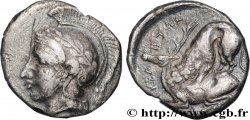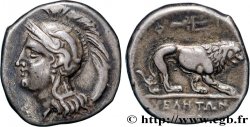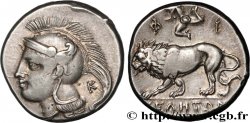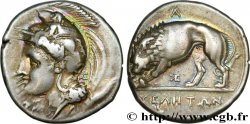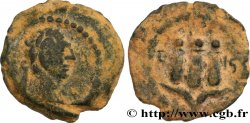Live auction - bgr_520044 - LUCANIA - VELIA Nomos, statère ou didrachme
Чтобы принять участие в торгах, вы должны войти в систему и стать подтвержденным участником аукциона. Войдите, чтобы сделать ставку. Ваш аккаунт будет подтвержден в течение 48 часов. Не ждите до закрытия торгов, чтобы зарегистрироваться.Сделав ставку на данный товар, вы вступаете в юридическое соглашение на покупку выбранного товара и нажатием кнопки «Сделать ставку» подтверждаете принятие вами условий интернет-аукционов cgb.fr.
Ставка может бить сделана только в полном эквиваленте евро. Торги закроются согласно времени, указанному в описании товара, все ставки, сделанные после закрытия торгов, учитываться не будут. Не следует откладывать предложение вашей ставки до последнего момента, так как система может не успеть обработать вашу заявку, и ваша ставка не будет принята. Более детальную информацию вы найдёте здесь: FAQ по интернет-аукционам.
Все ставки победителей подлежат комиссии 18%.
Все ставки победителей подлежат комиссии 18%.
| Оценить : | 550 € |
| Цена : | Нет ставки |
| Максимальная предлагаемая цена : | Нет ставки |
| Конец торгов : | 29 January 2019 14:05:00 |
Тип Nomos, statère ou didrachme
Дата: c. 350/340 - 320/310 AC.
Монетный двор / Город: Vélia, Lucanie
Металл: silver
Диаметр: 20 mm
Ориентация осей монеты: 6 h.
Вес: 7,49 g.
Редкость: R1
Комментарии о состоянии
Exemplaire sur un flan ovale bien centré des deux côtés. Belle tête d’Athéna. Joli revers. Belle patine de médaillier avec des reflets dorés irisés bleutés
Ссылки в каталоге: :
Лицевая сторона
Аверс: легенда: ANÉPIGRAPHE ; MONOGRAMME DERRIÈRE LE CASQUE.
Аверс: описание: Tête d'Athéna à gauche, coiffée du casque phrygien à cimier avec triple aigrette, orné d'un centaure.
Аверс: легенда: (KE)
Обратная сторона
Реверс: Описание: Lion passant à gauche, dévorant une proie.
Реверс: легенда: ULHTWN/ A/ (KE)
Комментарий
De mêmes coins que les exemplaires de l’Ashmolean Museum d’Oxford (SNG Oxford, 1279 à 1281). La série 60 du classement de Williams se caractérise par un monogramme qui correspond à la signature du graveur Kléodoros. Sur cet exemplaire, on distingue très nettement un début de cassure de coin au droit devant le visage. Au revers, on remarque la présence de deux minuscules points devant l’antérieur et sous la queue. Très tôt, le monnayage de Vélia a été décrit comme ayant inspiré la drachme lourde de Marseille (LT. 785-791). Certains l’ont même décrit comme un monnayage symmachique : un lion de Vélia étant l’équivalent de deux lions de Marseille. Aujourd’hui, cette théorie est remise en cause.
Same dies as the examples in the Ashmolean Museum in Oxford (SNG Oxford, 1279 to 1281). Series 60 of the Williams classification is characterized by a monogram that corresponds to the signature of the engraver Kleodoros. On this example, we can clearly see the beginnings of a die break on the obverse in front of the face. On the reverse, we note the presence of two tiny dots in front of the fore-end and under the tail. Very early on, the coinage of Velia was described as having inspired the heavy drachma of Marseille (LT. 785-791). Some have even described it as a symmachic coinage: one lion of Velia being the equivalent of two lions of Marseille. Today, this theory is being challenged
Same dies as the examples in the Ashmolean Museum in Oxford (SNG Oxford, 1279 to 1281). Series 60 of the Williams classification is characterized by a monogram that corresponds to the signature of the engraver Kleodoros. On this example, we can clearly see the beginnings of a die break on the obverse in front of the face. On the reverse, we note the presence of two tiny dots in front of the fore-end and under the tail. Very early on, the coinage of Velia was described as having inspired the heavy drachma of Marseille (LT. 785-791). Some have even described it as a symmachic coinage: one lion of Velia being the equivalent of two lions of Marseille. Today, this theory is being challenged








 Cообщить об ошибке
Cообщить об ошибке Распечатать страницу
Распечатать страницу Отправить мой выбор
Отправить мой выбор Задать вопрос
Задать вопрос Consign / sell
Consign / sell
 Информация
Информация